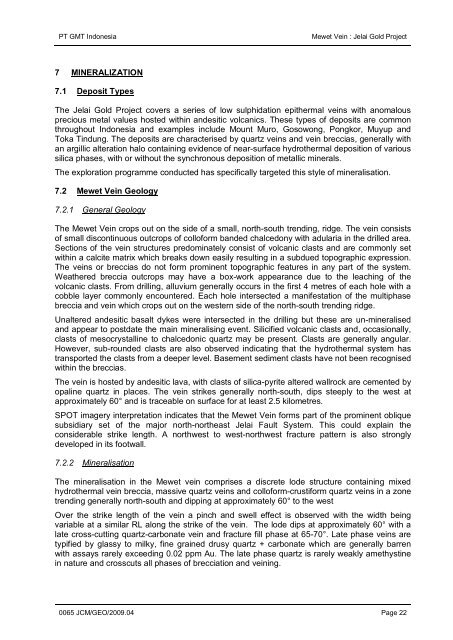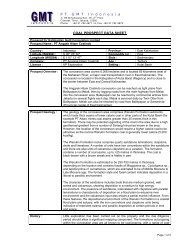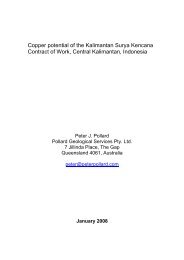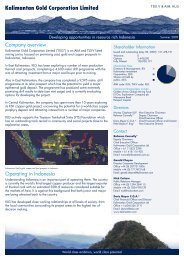Geology and mineralisation of the Mewet Vein, Jelai Gold Project ...
Geology and mineralisation of the Mewet Vein, Jelai Gold Project ...
Geology and mineralisation of the Mewet Vein, Jelai Gold Project ...
You also want an ePaper? Increase the reach of your titles
YUMPU automatically turns print PDFs into web optimized ePapers that Google loves.
PT GMT Indonesia<br />
<strong>Mewet</strong> <strong>Vein</strong> : <strong>Jelai</strong> <strong>Gold</strong> <strong>Project</strong><br />
7<br />
7.1<br />
MINERALIZATION<br />
Deposit Types<br />
The <strong>Jelai</strong> <strong>Gold</strong> <strong>Project</strong> covers a series <strong>of</strong> low sulphidation epi<strong>the</strong>rmal veins with anomalous<br />
precious metal values hosted within <strong>and</strong>esitic volcanics. These types <strong>of</strong> deposits are common<br />
throughout Indonesia <strong>and</strong> examples include Mount Muro, Gosowong, Pongkor, Muyup <strong>and</strong><br />
Toka Tindung. The deposits are characterised by quartz veins <strong>and</strong> vein breccias, generally with<br />
an argillic alteration halo containing evidence <strong>of</strong> near-surface hydro<strong>the</strong>rmal deposition <strong>of</strong> various<br />
silica phases, with or without <strong>the</strong> synchronous deposition <strong>of</strong> metallic minerals.<br />
The exploration programme conducted has specifically targeted this style <strong>of</strong> <strong>mineralisation</strong>.<br />
7.2<br />
7.2.1<br />
<strong>Mewet</strong> <strong>Vein</strong> <strong>Geology</strong><br />
General <strong>Geology</strong><br />
The <strong>Mewet</strong> <strong>Vein</strong> crops out on <strong>the</strong> side <strong>of</strong> a small, north-south trending, ridge. The vein consists<br />
<strong>of</strong> small discontinuous outcrops <strong>of</strong> coll<strong>of</strong>orm b<strong>and</strong>ed chalcedony with adularia in <strong>the</strong> drilled area.<br />
Sections <strong>of</strong> <strong>the</strong> vein structures predominately consist <strong>of</strong> volcanic clasts <strong>and</strong> are commonly set<br />
within a calcite matrix which breaks down easily resulting in a subdued topographic expression.<br />
The veins or breccias do not form prominent topographic features in any part <strong>of</strong> <strong>the</strong> system.<br />
Wea<strong>the</strong>red breccia outcrops may have a box-work appearance due to <strong>the</strong> leaching <strong>of</strong> <strong>the</strong><br />
volcanic clasts. From drilling, alluvium generally occurs in <strong>the</strong> first 4 metres <strong>of</strong> each hole with a<br />
cobble layer commonly encountered. Each hole intersected a manifestation <strong>of</strong> <strong>the</strong> multiphase<br />
breccia <strong>and</strong> vein which crops out on <strong>the</strong> western side <strong>of</strong> <strong>the</strong> north-south trending ridge.<br />
Unaltered <strong>and</strong>esitic basalt dykes were intersected in <strong>the</strong> drilling but <strong>the</strong>se are un-mineralised<br />
<strong>and</strong> appear to postdate <strong>the</strong> main mineralising event. Silicified volcanic clasts <strong>and</strong>, occasionally,<br />
clasts <strong>of</strong> mesocrystalline to chalcedonic quartz may be present. Clasts are generally angular.<br />
However, sub-rounded clasts are also observed indicating that <strong>the</strong> hydro<strong>the</strong>rmal system has<br />
transported <strong>the</strong> clasts from a deeper level. Basement sediment clasts have not been recognised<br />
within <strong>the</strong> breccias.<br />
The vein is hosted by <strong>and</strong>esitic lava, with clasts <strong>of</strong> silica-pyrite altered wallrock are cemented by<br />
opaline quartz in places. The vein strikes generally north-south, dips steeply to <strong>the</strong> west at<br />
approximately 60° <strong>and</strong> is traceable on surface for at least 2.5 kilometres.<br />
SPOT imagery interpretation indicates that <strong>the</strong> <strong>Mewet</strong> <strong>Vein</strong> forms part <strong>of</strong> <strong>the</strong> prominent oblique<br />
subsidiary set <strong>of</strong> <strong>the</strong> major north-nor<strong>the</strong>ast <strong>Jelai</strong> Fault System. This could explain <strong>the</strong><br />
considerable strike length. A northwest to west-northwest fracture pattern is also strongly<br />
developed in its footwall.<br />
7.2.2<br />
Mineralisation<br />
The <strong>mineralisation</strong> in <strong>the</strong> <strong>Mewet</strong> vein comprises a discrete lode structure containing mixed<br />
hydro<strong>the</strong>rmal vein breccia, massive quartz veins <strong>and</strong> coll<strong>of</strong>orm-crustiform quartz veins in a zone<br />
trending generally north-south <strong>and</strong> dipping at approximately 60° to <strong>the</strong> west<br />
Over <strong>the</strong> strike length <strong>of</strong> <strong>the</strong> vein a pinch <strong>and</strong> swell effect is observed with <strong>the</strong> width being<br />
variable at a similar RL along <strong>the</strong> strike <strong>of</strong> <strong>the</strong> vein. The lode dips at approximately 60° with a<br />
late cross-cutting quartz-carbonate vein <strong>and</strong> fracture fill phase at 65-70°. Late phase veins are<br />
typified by glassy to milky, fine grained drusy quartz + carbonate which are generally barren<br />
with assays rarely exceeding 0.02 ppm Au. The late phase quartz is rarely weakly amethystine<br />
in nature <strong>and</strong> crosscuts all phases <strong>of</strong> brecciation <strong>and</strong> veining.<br />
0065 JCM/GEO/2009.04 Page 22










